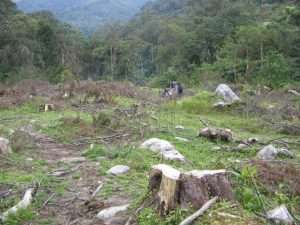Colombia’s Amazon Burns as Peace Fails
The Guardian’s article, “Colombia deforestation surged 35% in 2024 amid faltering peace talks,” pegs the loss at 154,000 hectares—about 380,000 acres. That’s a sharp climb from 2023’s 112,000 hectares. The Amazon bore the brunt. Armed groups, stalled peace talks, and illegal land grabs fuelled this spike. It’s a burning issue—literally and figuratively. Here’s why it stands out.
The story’s specific. It names the year, the percentage, and the hectares lost. Data from Colombia’s environment ministry backs it up. No vague warnings here—just hard numbers. The Amazon’s role makes it global. Forests there trap carbon and regulate weather. Lose them, and we all feel it. I’ve walked through logged areas in South America—stumps where trees stood feel like a punch to the gut.

Deforestation around the Medellín River
Why’s it hot? Peace talks with FARC dissidents collapsed. Chaos followed. Loggers, ranchers, and coca growers rushed in. The ministry points to “territorial control” by these groups. In 2023, deforestation dipped—a glimmer of hope. Now, it’s back with a vengeance. The Guardian ties this to human conflict, not climate shifts. That’s raw and real.
Numbers hit harder. The 35% jump translates to 42,000 extra hectares gone. That’s over 100,000 acres. World Resources Institute says deforestation drives 8% of global emissions. Colombia’s slice matters. Last year, I cut my own wood use after reading stats like these. Small moves don’t fix this, though—policy does.
What can you do? Pressure matters. Governments and groups like FARC need heat. I wrote my local rep about forest funding once—got a bland reply, but it’s a start. You could too. Ask: why let peace fail when forests burn? The Amazon’s not Colombia’s alone—it’s yours too.
Other issues—like ocean warming—compete. But this one’s immediate. Trees fall today. The Guardian’s focus on 2024’s surge, tied to armed chaos, makes it urgent. It’s not a slow melt—it’s a chainsaw massacre.
-
The Guardian, “Colombia deforestation surged 35% in 2024 amid faltering peace talks,” https://www.theguardian.com/environment/2025/feb/24/colombia-deforestation-surged-35-in-2024-amid-faltering-peace-talks
-
World Resources Institute, “Forest Loss and Climate Change,” https://www.wri.org/insights/forests-and-climate-change

Leave A Comment
You must be logged in to post a comment.